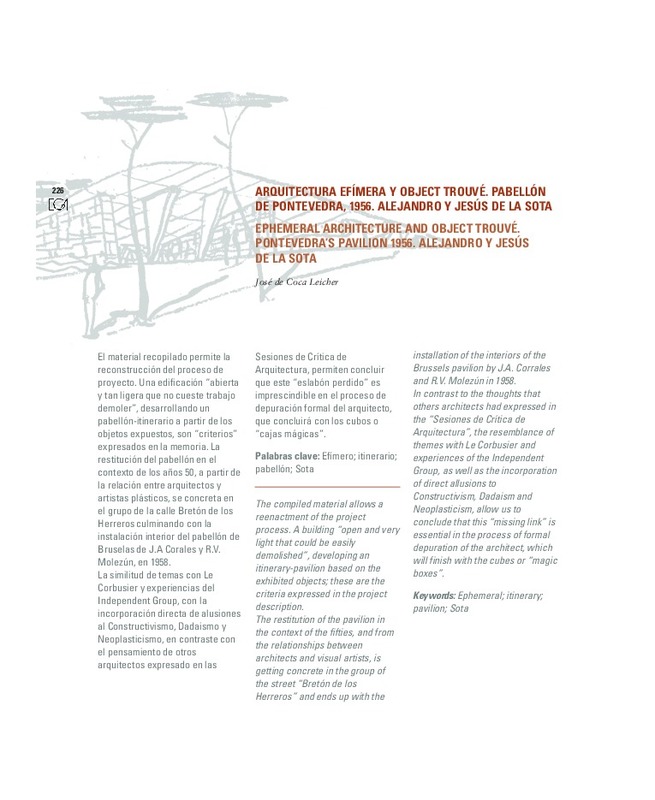JavaScript is disabled for your browser. Some features of this site may not work without it.
Buscar en RiuNet
Listar
Mi cuenta
Estadísticas
Ayuda RiuNet
Admin. UPV
ARQUITECTURA EFÍMERA Y OBJECT TROUVÉ. PABELLÓN DE PONTEVEDRA, 1956. ALEJANDRO Y JESÚS DE LA SOTA
Mostrar el registro sencillo del ítem
Ficheros en el ítem
| dc.contributor.author | Coca Leicher, José de
|
es_ES |
| dc.date.accessioned | 2013-02-15T12:38:48Z | |
| dc.date.available | 2013-10-23T22:30:50Z | |
| dc.date.issued | 2012 | |
| dc.identifier.issn | 1133-6137 | |
| dc.identifier.uri | http://hdl.handle.net/10251/22703 | |
| dc.description.abstract | [EN] The compiled material allows a reenactment of the project process. A building "open and very light that could be easily demolished", developing an itinerary-pavilion based on the exhibited objects; these are the criteria expressed in the project description. The restitution of the pavilion in the context of the fifties, and from the relationships between architects and visual artists, is getting concrete in the group of the street "Bretón de los Herreros" and ends up with the installation of the interiors of the Brussels pavilion by J.A. Corrales and R.V. Molezún in 1958. In contrast to the thoughts that others architects had expressed in the "Sesiones de Crítica de Arquitectura", the resemblance of themes with Le Corbusier and experiences of the Independent Group, as well as the incorporation of direct allusions to Constructivism, Dadaism and Neoplasticism, allow us to conclude that this "missing link" is essential in the process of formal depuration of the architect, which will finish with the cubes or "magic boxes" | es_ES |
| dc.description.abstract | [ES] El material recopilado permite la reconstrucción del proceso de proyecto. Una edificación "abierta y tan ligera que no cueste trabajo demoler", desarrollando un pabellón-itinerario a partir de los objetos expuestos, son "criterios" expresados en la memoria. La restitución del pabellón en el contexto de los años 50, a partir de la relación entre arquitectos y artistas plásticos, se concreta en el grupo de la calle Bretón de los Herreros culminando con la instalación interior del pabellón de Bruselas de J.A Corales y R.V. Molezún, en 1958. La similitud de temas con Le Corbusier y experiencias del Independent Group, con la incorporación directa de alusiones al Constructivismo, Dadaismo y Neoplasticismo, en contraste con el pensamiento de otros arquitectos expresado en las Sesiones de Crítica de Arquitectura, permiten concluir que este "eslabón perdido" es imprescindible en el proceso de depuración formal del arquitecto, que concluirá con los cubos o "cajas mágicas". | es_ES |
| dc.language | Español | es_ES |
| dc.language | Inglés | |
| dc.publisher | Editorial Universitat Politècnica de València | es_ES |
| dc.relation.ispartof | EGA. Revista de Expresión Gráfica Arquitectónica | |
| dc.rights | Reserva de todos los derechos | es_ES |
| dc.subject | Efímero | es_ES |
| dc.subject | Itinerario | es_ES |
| dc.subject | Pabellón | es_ES |
| dc.subject | Sota | es_ES |
| dc.subject | Ephemeral | es_ES |
| dc.subject | Itinerary | es_ES |
| dc.subject | Pavilion | es_ES |
| dc.title | ARQUITECTURA EFÍMERA Y OBJECT TROUVÉ. PABELLÓN DE PONTEVEDRA, 1956. ALEJANDRO Y JESÚS DE LA SOTA | es_ES |
| dc.title.alternative | EPHEMERAL ARCHITECTURE AND OBJECT TROUVÉ. PONTEVEDRA¿S PAVILION 1956. ALEJANDRO Y JESÚS DE LA SOTA | es_ES |
| dc.type | Artículo | es_ES |
| dc.date.updated | 2013-02-15T12:26:08Z | |
| dc.identifier.doi | 10.4995/ega.2012.1444 | |
| dc.rights.accessRights | Abierto | es_ES |
| dc.description.bibliographicCitation | Coca Leicher, JD. (2012). ARQUITECTURA EFÍMERA Y OBJECT TROUVÉ. PABELLÓN DE PONTEVEDRA, 1956. ALEJANDRO Y JESÚS DE LA SOTA. EGA. Revista de Expresión Gráfica Arquitectónica. 17(20):226-235. https://doi.org/10.4995/ega.2012.1444 | es_ES |
| dc.description.accrualMethod | SWORD | es_ES |
| dc.relation.publisherversion | https://doi.org/10.4995/ega.2012.1444 | es_ES |
| dc.description.upvformatpinicio | 226 | |
| dc.description.upvformatpfin | 235 | |
| dc.description.volume | 17 | |
| dc.description.issue | 20 | |
| dc.identifier.eissn | 2254-6103 |








